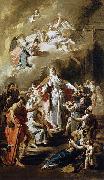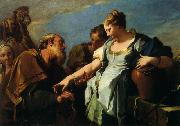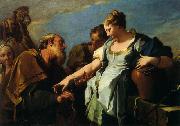Giambattista Pittoni Olja Måleriet ReproduceringAll Giambattista Pittoni Oil Paintings(1687 -- 1767) was an Italian painter of the late-Baroque or Rococo period, active mainly in his native Venice. Pittoni is best known for his "grand-manner" canvases depicting religious, historical, and mythological subjects (such as Sophonisba and Polyxena). He was a co-founder of the official painter's academy in Venice (in competition to the old fraglia or painter's guild), the Accademia di Belle Arti di Venezia, and he succeeded as President (1758?C1761) his contemporary Giovanni Battista Tiepolo. Pittoni never left his native Venice, but completed commissions from German, Polish, Russian, and Austrian patrons. His mature palette was noted, as was Tiepolo's, for his lightness of tone. Besides Tiepolo, Pittoni's influences were Giovanni Battista Piazzetta, Sebastiano Ricci, and Antonio Balestra. His paintings were of a Rococo style, but later became more sedate in their approach towards Neoclassicism. |
|||

|
|||
|
|
|||
|
||||||||
| Giambattista Pittoni (1687 -- 1767) was an Italian painter of the late-Baroque or Rococo period, active mainly in his native Venice. Pittoni is best known for his "grand-manner" canvases depicting religious, historical, and mythological subjects (such as Sophonisba and Polyxena). He was a co-founder of the official painter's academy in Venice (in competition to the old fraglia or painter's guild), the Accademia di Belle Arti di Venezia, and he succeeded as President (1758?C1761) his contemporary Giovanni Battista Tiepolo. Pittoni never left his native Venice, but completed commissions from German, Polish, Russian, and Austrian patrons. His mature palette was noted, as was Tiepolo's, for his lightness of tone. Besides Tiepolo, Pittoni's influences were Giovanni Battista Piazzetta, Sebastiano Ricci, and Antonio Balestra. His paintings were of a Rococo style, but later became more sedate in their approach towards Neoclassicism. |
||||||||
|
|
||||||||
| Måleriet Identifieringen :: 68577 St Elizabeth Distributing Alms 1734 Oil on canvas 72 x 43 cm |
||||||||
|
|
||||||||
| Måleriet Identifieringen :: 68778 St Elizabeth Distributing Alms 1734 oil on canvas 72 x 43 cm |
||||||||
|
|
||||||||
| Måleriet Identifieringen :: 71903 Eliezer and Rebecca 18th century Oil on canvas 168 x 130 cm (66.14 x 51.18 in) |
||||||||
|
|
||||||||
| Måleriet Identifieringen :: 73180 Eliezer and Rebecca Date 18th century Medium Oil on canvas Dimensions 168 X 130 cm (66.14 X 51.18 in) cyf |
||||||||
|
|
||||||||
| Måleriet Identifieringen :: 74791 Saint Roch 1727 Oil on canvas 42 x 32 cm cjr |
||||||||
|
|
||||||||
| FÖREGÅENDE KONSTNÄR Nästa Konstnär | ||||||||
|
|
||||||||
|
Giambattista Pittoni (1687 -- 1767) was an Italian painter of the late-Baroque or Rococo period, active mainly in his native Venice. Pittoni is best known for his "grand-manner" canvases depicting religious, historical, and mythological subjects (such as Sophonisba and Polyxena). He was a co-founder of the official painter's academy in Venice (in competition to the old fraglia or painter's guild), the Accademia di Belle Arti di Venezia, and he succeeded as President (1758?C1761) his contemporary Giovanni Battista Tiepolo. Pittoni never left his native Venice, but completed commissions from German, Polish, Russian, and Austrian patrons. His mature palette was noted, as was Tiepolo's, for his lightness of tone. Besides Tiepolo, Pittoni's influences were Giovanni Battista Piazzetta, Sebastiano Ricci, and Antonio Balestra. His paintings were of a Rococo style, but later became more sedate in their approach towards Neoclassicism. |
||||||||
|
|
||||||||
|
KOMMA I KONTAKT MED Oss |










